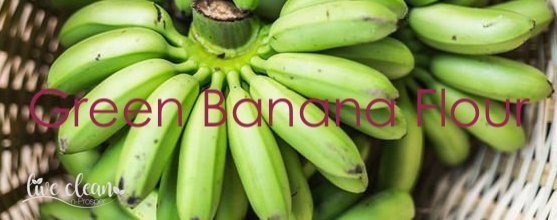This week’s post is about Green Banana flour.
It’s relatively new to Australia, but it’s already getting a lot of attention due to its many health benefits.
What is it?
Banana flour is a powder made from un-ripe (green) bananas. Historically, banana flour has been used in Africa and Jamaica as early as the 1900’s, as a cheaper alternative to wheat flour. The flour is generally produced using green bananas that are peeled, chopped, dried, and then ground.
Is Banana flour healthy?
The flour is gluten free, high in potassium, magnesium, dietary fibre and vitamin E. It is now often used as a gluten-free replacement for wheat flours. It is also one of the richest sources of resistance starch in the world.
However, not all resistant starches are made equal. Of the handful of foods that contain resistant starch, the quantity is low and it can be destroyed through cooking or it comes from genetically modified sources. The cooking process does not destroy the resistant starch in the banana flour.
In 2013 Robert Watkins, a Queensland Banana Farmer, discovered the richest source of resistant starch in a variety of bananas known as Lady Fingers. While regular bananas (they must be green) consumed by the mass market such as Cavendish still contain resistant starch, they only contain approximately half the amount found in Lady Fingers.
The starchy unripe Lady Finger bananas are also low in sugar. As a result, the milled flour can help people better control their blood glucose. It also provides a range of digestive benefits, making it a powerful new gut health ingredient. Nutritional studies in the area of resistant starches have revealed enzyme-resistant starches produce important metabolites in the colon. These metabolites appear to have important biological effects, which can lead to improved physical and mental health.
Health benefits
The flour contains 3 different fibres
– Resistant starch, a fermentable fibre
– Inulin, soluble fibre and
– Dietary Fibre or insoluble fibre
These fibres work like a prebiotic. When the fibres enter your digestive system they encourage production of digestive enzymes that nourish the good gut bacteria and in turn heals your gut.
These fibres also increase the absorption and capacity of antioxidants and minerals. They improve colon health and aide in the prevention of colon cancer. Together the fibres also aide in the treatment of diabetes, lower cholesterol and triglyceride levels, a well as reduce the incidence of gallstones.
Resistant starch can also assist with weight loss, as you feel quite full after consuming a small amount. Resistant Starch in this form also increases metabolism and removes aflatoxins and inflammation. (Sources – www.ncbi.nlm.nih.gov www.naturalevolutionfoods.com.au www.wikipedia.org www.thesourcebulkfoods.com.au )
Repurposed “waste”
There is approximately 500 tonne of Lady Finger bananas going to waste every week in Australia. This is due to being considered ‘unsuitable’ according to supermarket guidelines. The fruit are perfectly good for eating and packed full of nutrients yet “unwanted” by the supermarket giants because they were too straight, too bendy, too big or too small.
Rather than disposing of the tonnes of “waste” bananas, Robert Watkins developed a manufacturing process to turn the bananas into flour.
What began as a purpose and use for tonnes of wasted bananas each week has evolved into a new market for all growers. Mr Watkins is continuing to research how the nutrient dense green bananas can be utilised in different ways.
It’s fantastic to see how one farmer can have such a positive impact on a whole industry.
Till the next post,
Live clean n prosper


